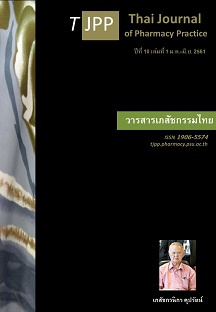การขับเคลื่อนนโยบายการพัฒนามาตรฐานของร้านยาในจังหวัดอุดรธานี
Main Article Content
บทคัดย่อ
วัตถุประสงค์: เพื่อศึกษาการขับเคลื่อนนโยบายในการพัฒนามาตรฐานของร้านยา และศึกษาแนวทางพัฒนามาตรฐานของร้านยาในจังหวัดอุดรธานี วิธีการ: การวิจัยนี้เป็นการศึกษาเชิงพรรณนาซึ่งแบ่งเป็น 2 ระยะ ระยะที่หนึ่งเป็นการรวบรวมและทบทวนกฎหมายที่เกี่ยวข้อง รายงานประจำปี และโครงการรับรองร้านยาคุณภาพเพื่อสรุปสถานการณ์การขับเคลื่อนนโยบายการพัฒนาร้านยา ระยะที่สองเก็บข้อมูลด้วยการสัมภาษณ์ผู้ประกอบการร้านยาในจังหวัดอุดรธานีจำนวน 30 ราย ที่ผู้วิจัยได้คัดเลือกแบบเจาะจงจากกลุ่มผู้ประกอบการ 3 กลุ่ม ได้แก่ กลุ่มผ่านมาตรฐาน กลุ่มที่มีเภสัชกรอยู่ปฏิบัติการตลอดเวลาที่เปิดร้าน และกลุ่มที่เภสัชกรไม่ได้อยู่ปฏิบัติการตลอดเวลาที่เปิดร้าน การสัมภาษณ์กึ่งโครงสร้างทำโดยให้ตัวอย่างประเมินตนเองถึงการรับรู้กฎกระทรวงเรื่องการขออนุญาตและการออกใบอนุญาตขายยาแผนปัจจุบัน พ.ศ. 2556 และประเมินความพร้อมต่อการปฏิบัติตามหลักวิธีปฏิบัติทางเภสัชกรรมชุมชน (Good Pharmacy Practice: GPP) ผลการวิจัย: นโยบายและมาตรการทางกฎหมายมีผลบังคับให้ต้องปฏิบัติตามมาตรฐาน จึงเกิดการขับเคลื่อนตามนโยบายอย่างเห็นได้ชัด จังหวัดอุดรธานีมีร้านยาแผนปัจจุบันจำนวน 215 แห่ง เป็นร้านยาคุณภาพหรือร้านผ่านเกณฑ์ GPP จำนวน 55 แห่ง (ร้อยละ 25.5) ตัวอย่างที่ให้สัมภาษณ์ทุกรายทราบถึงกฎกระทรวงฯ ร้านยากลุ่มที่มีเภสัชกรอยู่ปฏิบัติการตลอดเวลาที่เปิดร้านมีแนวโน้มปฏิบัติตามแนวทางพัฒนาได้ทุกหมวดตามเกณฑ์ GPP ส่วนร้านเภสัชกรที่ไม่ได้อยู่ปฏิบัติการตลอดที่เปิดร้าน จะไม่พร้อมในหมวดการควบคุมคุณภาพยา รองลงมา คือ หมวดบุคคลากรและหมวดวิธีการปฏิบัติตามวิธีปฏิบัติทางเภสัชกรรมชุมชน ตามลำดับ สรุป: เพื่อให้แนวทางการพัฒนามาตรฐานของร้านยาเกิดผลสัมฤทธิ์ หน่วยงานภาครัฐควรให้คำแนะนำในการดำเนินการตามเกณฑ์ GPP แก่ร้านยา และสร้างความเข้าใจโดยเน้นเตือนและติดตามการปฏิบัติตามแนวทางที่กำหนดเพื่อให้ร้านยาได้ปรับปรุงยกระดับมาตรฐานก่อนมีการบังคับใช้กฎหมายอย่างเคร่งครัดต่อไป
Article Details
ผลการวิจัยและความคิดเห็นที่ปรากฏในบทความถือเป็นความคิดเห็นและอยู่ในความรับผิดชอบของผู้นิพนธ์ มิใช่ความเห็นหรือความรับผิดชอบของกองบรรณาธิการ หรือคณะเภสัชศาสตร์ มหาวิทยาลัยสงขลานครินทร์ ทั้งนี้ไม่รวมความผิดพลาดอันเกิดจากการพิมพ์ บทความที่ได้รับการเผยแพร่โดยวารสารเภสัชกรรมไทยถือเป็นสิทธิ์ของวารสารฯ
เอกสารอ้างอิง
2. Bureau of Drug Control, Food and Drug Administration, Ministry of Public Health. Statistics on Drugs Licenses in Thailand, 2007–2014. [online] 2014 [cited Oct 10, 2016]. Available from: drug.fda. moph.go.th/zone_law/law039.asp
3. Public Health Ministerial Rule in 2013 on license application and licensing of modern drug selling. Royal Gazette No.130, Part 126A (Dec 27, 2013)
4. Kaew-on P, Lerkiatbundit S, Saengcharoen W. Is there any differences in the quality between the pharmacy council and non-accredited pharmacies? Thai Journal of Pharmacy Practice 2012; 4:39-64.
5. The Pharmacy Council of Thailand. List and address of accredited community pharmacy [online] 2015 [cited Oct 18, 2016]. Available from: www.pharmacy council.org/index.php?option=content&menuid=39
6. Udonthani Provincial Public Health Office. Directory of drugstores in Udonthani Province, 2016.
7. Parinyarux P, Suwannaprom P. Attitudes and stage of change towards participation to the community pharmacy development and accreditation project of pharmacist drug store owners in Muang district, Chiang Mai province. Thai Pharmaceutical and Health Science Journal 2014; 9: 164-9.
8. Sethsunthree P. Factors affecting the drugstores tendency to join the pharmacy advancement project for quality drugstore. Department of Health Service Support Journal 2012; 9: 44-55.
9. Intariya I. Inspection of the compliance to the Ministerial Rule on licensing and requirements on premises, instruments and good pharmacy practice among drugstores in Lamphun. Thai Journal of Pharmacy Practice 2015; 7: 94-104.
10. Wientong p, Chinwong D, Chinwong S. Readiness among community pharmacists in Chiang Mai to comply with the Ministerial Declaration on licensing and requirements on premises, instruments and good pharmacy practice. Thai Journal of Pharmacy Practice 2017; 9: 92-100.


